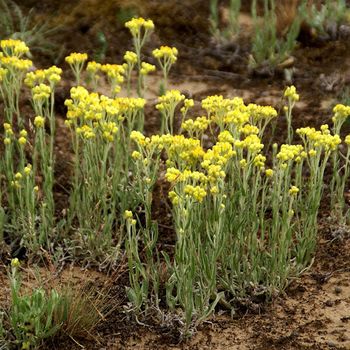Sandy Everlasting
Other Names: Helichrysum arenarium, Immortelle, Dwarf Everlast, Common Shrubby Everlasting, Eternal Flower, Gnaphale des Sables, Goldilocks, Helichrysum arenarium, Herbe à Curry, Immortelle des Dunes, Immortelle des Sables, Perliè re des Sables, Pluma de Príncipe, Siempreviva del Monte, Yellow Chaste Weed.
The plant grows on sandy grasslands, heathlands and in pine forests. Sandy everlasting [Helichrysum arenarium (L.) Moench] is herbaceous perennial plant belonging to Asteraceae family and it is native to Europe, Central Asia, and China. It belongs to the section Helichrysum (Asteraceae family, genus Helichrysum) alongwith H. plicatum DC. Prodr., which very similar phenolic profile and H. italicum (Roth), which is widely used for essential oil extraction.
See also : Helichrysum
Special Precautions of Sandy Everlasting
- Pregnancy and breast-feeding: Not enough is known about the use of immortelle during pregnancy and breast-feeding. Stay on the safe side and avoid use.
- Gallstones: Immortelle may cause colic (stomach cramps) in people with gallstones.
- Blocked bile duct: Don't use immortelle if you have a blocked bile duct, because immortelle might stimulate the flow of bile.
- Allergy to ragweed, daisies, and related plants: Immortelle may cause an allergic reaction in people who are sensitive to the Asteraceae/Compositae plant family. Members of this family include ragweed, chrysanthemums, marigolds, daisies, and many others. If you have allergies, be sure to check with your healthcare provider before taking immortelle.
Health Benefits and Uses of Sandy Everlasting
The flowers have a long tradition in European ethnomedicine as a cholagogue, choleretic, hepatoprotective, and detoxifyingherbal drug. The flowers are rich in phenolic compounds including flavonoids, chalcones, phenolic acids, coumarins, and pyrones. Apart from polyphenols, other compounds suchas sterols, lignans, and glycosides of aromatic compounds have been also isolatedfrom H. arenarium. The majority of authors confirm that the most important group of compounds responsible for biological activities is flavonoids. Moreover, significant activities of naringenin, one of the main flavonoids of H. arenarium, were reported. On the other hand, there are no clinical data about testing the extracts or preparations based on H. arenarium. Although H. arenarium is well known in phytotherapy for its potential in the treatment of gallbladder disease and are classified as endangered species in a number of European countries, very few data about its cultivation are available in the literature.
- The plant is considered to have anti-inflammatory, antibacterial, cholagogic, diuretic and spasmolytic properties.
- An infusion made usually from flowers is used in treatment of gall bladder disorder. It can also be very helpful as a diuretic in cases of cistitis and rheumatism. Some studies suggest that it can also significantly lower cholesterol levels.
